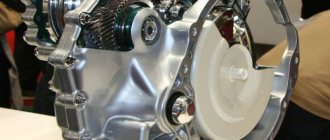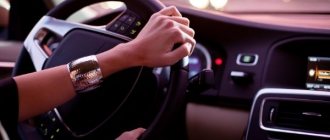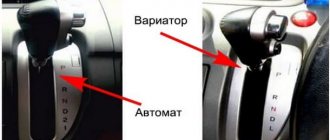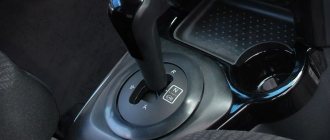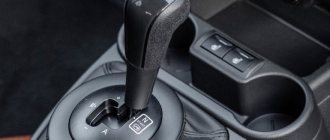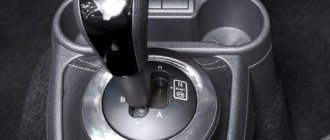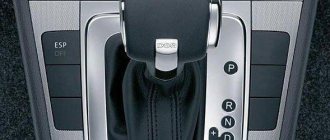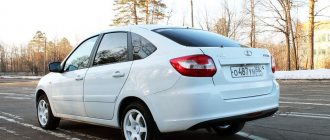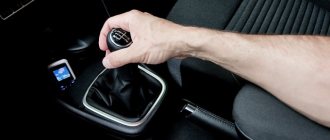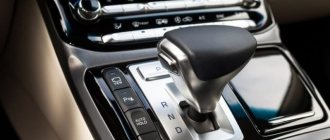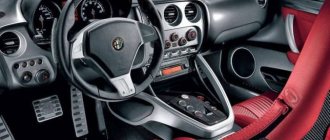There are 4 types of gearboxes (gearboxes). The share of cars with a robotic gearbox, classic automatic and CVT on the roads is constantly growing, because more and more motorists are abandoning manual mechanics. Transmissions that operate without human intervention are constantly being improved. Their quality, speed of reaction to road events, smoothness of actions become better, and any trip is more comfortable.
It is much more convenient with a robotic gearbox.
What is a robotic gearbox
A robotic gearbox (RMG, or robot) is part of a vehicle’s transmission. Sometimes it is confused with an automatic transmission, but they are different from each other. Manual transmission consists of a manual transmission, automatic switches of electric or hydraulic type (actuators) and a control unit for these switches (ECU). That is, the box itself is mechanical; only the control of its operation is automatic.
For the driver, the manual transmission looks almost like an automatic transmission. There is no gearshift lever at hand (on some models there is a selector knob instead), and there are no clutch pedals underfoot. While driving, gears are switched automatically.
How does a checkpoint robot work?
Most of the mechanisms are regulated by special intelligent robot gearbox units. What it is? Thanks to this, that is, the operation of the electronic system, it is possible to monitor all the necessary parameters for the gearbox. The sensors also analyze the position of the transmission, oil pressure and other parameters for transmission to the main unit. After this, the electronics will generate all the necessary actions that should be performed. In the form of short signals, they will be sent to the electric drive and electric valves, respectively, this will allow the gearbox to quickly but smoothly shift.
How it works
The manual transmission, equipped with a clutch disc connected to the engine flywheel, is controlled by a robot. The algorithm incorporated by the developers into the ECU reacts to sensor readings by sending commands to the servos.
It looks like this:
- the driver presses the gas pedal;
- engine speed increases, the car accelerates;
- upon reaching the values specified in the program, the clutch actuators and shift forks are activated;
- upshift occurs.
If the driver continues to accelerate, then at the next programmed engine speed and driving speed, the ECU again gives a signal and the actuators change gear again.
By the same principle, during braking, gears are switched from high to low. High-performance processors make it possible to create complex programs that simulate human behavior in different situations. And the more complex they are, the more dynamic and comfortable the ride.
What is manual transmission
In essence, the “robot” is a standard manual transmission, which lacks a gearshift lever and clutch. Instead, it contains servos (also called actuators). Thanks to them, information about the movement of the car (speed and other indicators) is converted into a digital format, which activates the movement of gears and shafts. One servo is responsible for engaging and disengaging the clutch, and the other moves the gears in the gearbox itself. Thus, there is no need to use the clutch pedal and manual gear shifting, which makes driving a car much easier.
However, there are several varieties of such structures. Manual transmission can be equipped with:
- Electric drive. Such gearboxes are cheaper and can be installed even on the most budget cars. In this case, control is carried out by an electric motor, gearbox and actuator. This leads to lower performance of such systems.
- Hydraulic system. In such devices, gear shifting is carried out by cylinders that are pushed by the force of solenoid valves. Hydraulic “robots” are more like a classic “automatic machine”. Gears change faster than with a conventional electric drive. In addition, the car drives more smoothly, without jerking. Manual transmissions with hydraulics are installed mainly on expensive cars.
Since robotic gearboxes are similar in their operating principle to automatic transmissions, many drivers have a dilemma regarding which device is better to choose. In this matter, much depends on operating conditions and other factors.
Features of manual transmission
Operation of a robotic gearbox.
The gear shift drives on robots are equipped with either electric motors or a piston hydraulic system. But they perform the same task - they move the synchronizers of the secondary shaft gears and depress the clutch.
The main difference is that hydraulics work faster and smoother. But it is more expensive to produce, so mainly high-class cars are equipped with such manual transmissions. The most popular is DSG from the German concern Volkswagen.
The ECU for the boxes is made both separate and combined with the internal combustion engine control unit. The latter option is most appropriate if the robot's control algorithm takes into account the readings of the same systems as engine control, for example ABS or ESP.
Peculiarities
The clutch drive can be electric or hydraulic. In the first case, it should be noted that there is an electric motor and a mechanical transmission. The second type of drive operates through the operation of special cylinders, which are controlled by an electromagnetic valve. In some cases, the robotic gearbox, the variator of which is well designed, is equipped with an electric motor. It moves the cylinders and is also designed to maintain the operation of the hydromechanical unit. A similar device that has a drive of this type is distinguished by the duration of the gear shift speed. As a rule, it varies from 0.3 to 0.5 seconds. However, when compared with hydraulic analogues, the system will not need to constantly maintain a certain pressure. A striking example of such a car is the Opel; the robotic gearbox on this car generally pleases many drivers.
Hydraulic gearboxes have a fast cycle, which provides gear changes in a time of 0.05 to 0.06 seconds. That is why such a transmission is most often used on racing cars and supercars. Examples are Ferrari and Lamborghini. On cars that belong to the budget class, such a gearbox cannot be supplied to a service station, even as an additional option.
Clutch device in a robot
Robotic boxes based on the method of interaction with the engine are of two types:
- single-disc;
- double-disc (use two clutches, activated alternately).
A single-disc box is no different from a mechanical one. It has a primary and secondary shaft.
The primary is connected to the clutch disc. The secondary shaft transmits torque directly to the wheels. Both shafts interact through gears of different diameters. Switching occurs at the moment when the gear selected for the desired gear on the secondary shaft is locked. In manual transmissions, this is done by electric manipulators that receive a signal from the ECU. Hydraulic manipulator drives on single-disk boxes are used extremely rarely.
Double-disc ones have two driving input shafts, each of which is connected to its own clutch disc. One shaft is responsible for even gears, and the second for odd and reverse gears. This technical solution made it possible to make the inclusion of the selected gear smoother. The drive synchronizers operate alternately. At the moment of transition on one shaft from 1st to 2nd gear, the ECU already gives a signal to prepare to engage 3. Therefore, they are also called preselective, i.e. with preliminary selection. As a result, the switching process itself is accelerated to 0.2 seconds or less.
Some manufacturers configure the operation of actuators and algorithms in such a way that the robot functions no worse than a human.
avtoexperts.ru
One of the branches of development of mechanical transmissions led engineers and designers to the creation of a robotic gearbox - a device in which gears are changed not by a person (by turning the clutch on and off), but by a “robot” - an electronically controlled mechanism. At the moment, this is one of the most progressive types of gearboxes installed on cars, which, however, has its pros and cons.
DSG robotic gearbox
The principle of a robotic gearbox
The platform for creating a robotic transmission was a manual gearbox. The designers decided that there was no point in inventing a completely new mechanism; it was enough to improve the existing one.
As you know, the principle of operation of a manual transmission is to transmit torque from the engine through the input shaft to the secondary shaft, from which the torque goes to the main gear, and then to the drive wheels. The moment of gear shifting on the “mechanics” is carried out using the clutch mechanism, which is operated by the driver - by squeezing and releasing the clutch, he controls the gear shift from downshifting to upshifting, or in the reverse order.
In the mechanism of operation of the robotic transmission, engineers decided to entrust this mechanical moment of gear shifting to automation, removing direct human participation from the control circuit. In the “robot”, the clutch and gear shifting are controlled by special actuator units, which come in two types – clutch actuators and gear shift actuators. The former are responsible for opening/closing the input shaft with the engine, the latter are responsible for shifting gears. The actuators, in turn, are controlled by an electronic control unit, which clearly calculates the moment when the input shaft should be disconnected/connected and when an upshift or downshift should be engaged. When such a signal is received (the electronic control unit takes into account vehicle speed, engine speed, torque and other data), the clutch actuator disconnects the input shaft from the engine, and the gear actuator selects the desired gear. The clutch actuator then smoothly connects the input shaft to the engine and the car moves in high gear. The same process occurs when switching from upshift to downshift, as well as when driving in reverse. Such transmissions were installed on cars of many brands (for example, Toyota, Peugeot and others).
Robotic" 2-shaft gearbox with electro-hydraulic actuators (Citroen). Photo — Carexpert.ru
Like many mechanisms, the robotic transmission was imperfect (we will talk about its pros and cons later) and it was because of this that cars with first-generation “robots” were not popular with buyers. The situation was corrected with the entry into the market of second-generation robotic transmissions - with two clutches. They are also called preselective gearboxes.
Preselective DSG robot with two clutches.
Initially, cars of the Volkswagen concern (Volkswagen, Audi, Seat, Skoda) were equipped with such “robots”; today, cars of other brands (BMW, Ford, Fiat) are equipped with similar transmissions. Depending on the type of clutch, such gearboxes are divided into gearboxes with dry and wet clutch. The principle of operation of such a box is that the even and odd stages are spaced on different shafts (primary and secondary), and their activation is controlled by a separate clutch unit. The mechanism of such a box prepares the next stage for inclusion in advance (hence the name “preselective” - pre-selecting a gear), due to which this procedure occurs without disconnecting the gearbox from the engine, thereby not interrupting the torque from the engine to the drive wheels.
The question often arises: what are the differences between automatic and robotic transmissions? The answer is simple: in the device. A robotic gearbox is, as mentioned above, the same “mechanics”, only actuators are involved in turning on/off the clutch and shifting gears. An automatic transmission contains an important unit - a torque converter, which replaces the clutch mechanism and is the connecting link between the engine and the gearbox itself.
Advantages and disadvantages of “robots”
The positive aspects of the first generation of robotic gearboxes were the absence of a clutch pedal and a lower price than an automatic transmission. The negative aspect of these gearboxes was the imperfect mechanism for engaging subsequent gears, which caused the car to jerk, which brought discomfort to the driver and passengers. Another disadvantage of this box was the complexity and relatively high cost of its maintenance, which was higher than that of a traditional manual transmission.
The advantages of a preselective robotic gearbox include gear shift speed, efficiency (due to the absence of power loss when changing gears), and operation in fully automatic or “manual” mode. The disadvantages are the presence of jerks when driving in first gear, the high cost of repairs and maintenance. For example, such a characteristic disadvantage of many “robots” as the car rolling back when starting uphill (after all, the robotic transmission, despite the absence of the usual clutch mechanism, is the same “mechanics”) is quite unnerving for owners of cars with manual transmission and requires getting used to such peculiarities.
Operating modes
The driver's control of the gearbox comes down to selecting a mode using the selector:
- Neutral is designated "N". In this mode, the engine runs, but no torque is transmitted to the wheels. Turn it on before driving, after stopping, and during long-term parking.
- Forward movement is indicated by "A/M", "E/M" or "D". Having turned on this mode, release the brake pedal and press the gas pedal. The car moves forward, automatically switching gears depending on acceleration or braking.
- Manual control is designated "M". The car moves forward, the driver independently changes gears by pressing the steering wheel paddles or selector to the “+” or “-” positions. In this case, the switching occurs only by one stage.
- Reverse movement is indicated by “R”. By selecting this mode, you can drive backwards.
- Some manual transmissions may have “winter” and “sport” modes.
The concept of a robotic gearbox.
There are also some peculiarities when driving, which the driver must get used to, otherwise he will end up in unpleasant situations.
This is the following:
- Driving in automatic mode requires roads with good hard surfaces. If you drive into mud in the summer and deep, loose snow in the winter, you run the risk of stalling. The algorithm will begin to issue erroneous commands, and transmissions will not be switched on correctly. Such situations increase the wear of parts and mechanisms, which increases the risk of breakdowns.
- The gas pedal must be pressed smoothly; under no circumstances should it be pressed to the floor. It is necessary to monitor the engine speed, recording the moments of gear shifting, and avoid over-throttle.
- If your car does not have a hill start assist function, you need to do the same as when using a manual transmission - use the parking brake to prevent rolling back.
- When stopping for long periods (more than 60 seconds) at a red light or in a traffic jam, you need to switch the selector to the “neutral” position.
- For a long stop in a parking lot, first move the selector to “neutral”, then turn on the parking brake, then release the brake pedal and turn off the engine.
- Each manufacturer indicates how often the ECU needs to be recalibrated based on mileage (also called initialization or training). This must be done due to wear on the clutch disc. The procedure should be carried out every 10,000-15,000 km.
- In winter, at low air temperatures, warming up the box takes exactly as long as it takes to warm up the engine.
Regular machine
When choosing a vehicle with one of the types of automatic transmission, you need to know what an automatic and a robot are and what each of them consists of.
Read
What is better to choose: repairing an automatic transmission or buying a contract automatic transmission
Attention! Automatic transmission was first released in the 30s of the twentieth century. But they began to produce it en masse only in the sixties of the same century.
Vehicles with an automatic transmission are considered more reliable than those with a CVT or robot.
Automatic transmission design
The automatic transmission consists of a torque converter, a planetary gearbox, and a valve body.
| Automatic element | What is he responsible for? |
| The torque converter consists of a turbine and reactor wheel, a centrifugal pump, an overrunning and locking clutch | Responsible for smooth gear shifting and acts as a clutch |
| The planetary gearbox consists of gearboxes and friction discs, a brake band | Transmits force through a system of different gear engagement options, switches speeds |
The structure of the automatic transmission, as can be seen from the table, is simpler than that of a robot. Another difference from the robotic one is the large number of gear ratio steps. Thanks to them, vehicle fuel consumption is reduced.
The difference between a robot and an automatic transmission lies in the operating principle of the automatic transmission. Gear shifting occurs without interruption when the engine reaches maximum speed in one of the gears and pressure is built up in the oil system to change speed.
The principle is as follows:
- The torque converter changes the torque.
- The lubricant flows from the pump to the turbine wheel.
- The wheel transfers it to the reactor.
- The oil flow becomes greater and the pump wheel speed increases.
- The overrunning clutch is activated, thanks to which the reactor rotates.
- The clutch changes gears between planetary gearboxes.
Read
Changing the oil in an automatic transmission Opel Astra J: interval, analogues and materials
And the hydraulic cylinders, which ensure the operation of the processes described above, are controlled by an electronic unit.
As already described, an automatic transmission can be distinguished from a robot by the following positions of the handle on the selector:
- P – “Parking”;
- R – “Reverse”;
- N – “Neutral”;
- D – “Move forward”;
- L – “Forced downshift”.
Positives and negatives
Like all devices, the machine has its positive sides and negative features. The advantages of an automatic transmission include:
- reliability;
- simple controls;
- lack of periodic clutch replacement;
- economical fuel consumption;
- Doesn't roll back if placed on a slope.
The machine also has negative features, which consist of the following parameters:
- high cost when replacing the machine;
- high cost of major repairs;
- a vehicle with an automatic transmission cannot be started from a pusher;
- low efficiency due to the torque converter. The latter uses almost half of the device’s power;
- The device's lifespan is short.
The main differences between manual transmission and automatic transmission
Both types of transmission perform the same function - they free the driver from the need to change gears while the car is moving.
But due to the fact that these are structurally different mechanisms, they differ from each other in operation and maintenance:
- In an automatic transmission, ATF is part of the working mechanism. Manual transmissions contain oil to lubricate mechanical components, but it is several times less in volume. In addition, it needs to be changed much less often.
- A car with a robot is more dynamic in motion and consumes less fuel. Because the weight and dimensions of an automatic transmission exceed those of a robot, and gear shifts in a manual transmission occur faster.
- It’s much more comfortable to drive a car with an automatic transmission, because the gears shift smoothly, and a robotic gearbox cannot dampen jerks as much.
- The wear of the friction clutches is slower than the wear of the clutch disc.
- On a robotic box, you can switch to manual control. It is not complete, because switching is carried out only to one position and it is impossible to switch, for example, from 2 to 4 immediately. But the automatic transmission does not give the driver such an opportunity.
Weight Features
The weight of the box is quite an important issue. In this parameter, the transmission performs better than the automatic, since it is much lighter. The curb weight of such a box for passenger cars will be no more than 50 kg, while the weight of an automatic transmission only starts from this mark and reaches 100 kg in maximum positions. Accordingly, with a robot the car will be lighter, that is, the shock absorbers, wheels and engine do not experience heavy load.
Advantages and disadvantages
Robotic gearboxes have become widespread due to their advantages. However, they also have disadvantages, which it is better to know about before buying a car in order to be prepared for them.
Scheme of operation of the SensoDrive system.
Advantages:
- The acceleration time to 100 km/h, with other parameters being similar, is almost no different from the acceleration time with a manual transmission.
- Fuel consumption is comparable to that of cars with manual transmission and up to 30% lower than on models with automatic transmissions.
- The clutch disc wears out more slowly than with manual shifting.
- The robot works more accurately than a human, so the shafts and gears of the box will wear out less and last longer than in manual mechanics.
- The cost of repairs and maintenance is on average lower than that of an automatic transmission.
Negative points:
- While driving, jerking and jerking may be felt when shifting gears.
- The algorithm embedded in the ECU does not have a human reaction to situations that arise while driving. Therefore, errors may occur when it is necessary to urgently accelerate or brake.
- To make a decision, the robot needs longer gears, and to maintain dynamics, a more powerful engine is needed.
- If there is no hill assist system, then when starting to move uphill, the car may roll back.
- Impossibility of flashing the control unit. The gear shift algorithm is a manufacturer's development and cannot be adjusted.
- Traffic in traffic jams has a bad effect on the components and mechanisms of the box, leading to their early destruction.
Advantages and disadvantages
It is difficult to give a definitive answer as to which gearbox is better. CVT, automatic, robot, each of these transmissions has its own pros and cons. You can determine which of them is the most suitable option only after analyzing your requirements for the car.
The main positive aspects of the classic automatic gearbox:
- convenience of the gear shift mechanism;
- presence of manual switching mode;
- inability to overload the engine due to inept use of gears.
The negative features of the mechanism are as follows:
- high cost of servicing an automatic transmission;
- inability to tow a car;
- increased fuel consumption.
Positive features of a continuously variable automatic transmission, CVT:
- low fuel consumption;
- stepless acceleration;
- relatively light weight of the box equipment.
Negative features are:
- noisy operation of the mechanism as a whole;
- low design reliability
- high cost of box maintenance;
- difficulty in repairing the mechanism;
- negative impact of dynamic driving style.
The advantages of a robotic gearbox include:
- low cost of a robotic gearbox;
- low fuel and lubricant consumption (a standard automatic machine consumes 3-4 times more oil);
- simplicity of design, ease of repair of the robot;
- high clutch life, approximately 45% higher than competitors;
- ability to change gear control modes;
- faster gear changes.
Disadvantages of the mechanism:
- jerky gear shift;
- inability to tow;
- driving a robotic gearbox involves constant switching to neutral
- position of the gear lever when stopping at traffic lights. Failure to comply with this requirement
- quickly wears out and disables the clutch mechanism;
- The main malfunctions and shortcomings of the robot are also associated with the rapid deterioration of the clutch. If characteristic shocks, jerks, or extraneous sounds appear, it is necessary to urgently diagnose the mechanism.
Symptoms of a problem
Like any mechanism, a robotic box is subject to wear and tear during operation and can break. Malfunctions are divided into mechanical and control unit . Each has its own manifestations.
Signs of mechanical failure:
- slipping while driving on a flat, hard road surface indicates wear of the clutch disc;
- if the gears do not shift, this may indicate a breakdown of the actuators;
- extraneous noise while driving can be caused by a number of reasons, and to identify a breakdown, components and mechanisms should be diagnosed;
- increased jerking during gear shifting may occur due to wear and destruction of gear connections on the gearbox shafts, wear of the gear selection forks;
- The Check Engine light on the instrument panel indicates the need for computer diagnostics.
Signs of errors in the ECU:
- the robot’s operating mode is disrupted, gear shifts occur incorrectly and at the wrong time;
- jerking when shifting gears becomes stronger;
- when the selector selects the forward or backward driving position, the car does not move;
- The Check Engine light comes on.
To figure out why the trouble arose, you need to carry out correct diagnostics using special equipment.
Flaws
We have already looked at what an automatic robot box is, and we have also discussed the advantages of a machine running on such a device. However, it also has its drawbacks. You should find out which ones. For example, the main disadvantage is the speed of gear shifting. Because of this, a lot of pressure can be placed on the car, especially if a person is stuck in a traffic jam. Often the car accelerates with jerks, which is more suitable for sporty driving. That is why for all lovers of quiet driving, the manufacturers of such gearboxes install a special mode. And if this problem can be dealt with, then the safety of driving on slopes in such a car is a rather pressing issue.
The robotic gearbox does not receive constant signals from the engine. That is why it can often turn off, and accordingly, the car will roll down the slope. But, fortunately, judging by the reviews, few people found themselves in such a situation. In general, taking into account all the negative aspects, this box can still be called one of the best.
Relevance of the box in Russia
Cars with robotic gearboxes are in good demand among our car enthusiasts. Surveys show that the share of Russians willing to buy a car with a manual transmission ranges from 15-20%. It should be noted that the share of those who want to use a classic machine is still 2 times higher.
In large cities, solvent segments of the population choose automatic transmissions because of a more comfortable ride and much fewer problems associated with operation in conditions of frequent traffic jams. Moreover, the prices for an automatic machine and a good preselective unit are at the same level. But, if the price of fuel continues to rise, many will prefer a car with a manual transmission (as it is cheaper to operate), especially when trips are not limited to the work-home route.
Operating principle of manual transmission
Robotic gearboxes can operate in automatic and semi-automatic (manual) modes. Automatic mode involves controlling the gearbox electronically based on data received from external sensors, by implementing the selected operating algorithm through actuators.
Semi-automatic mode (manual) involves selecting and shifting gears manually. Manual mode allows smooth shifting from low to high gears using the selector lever or steering wheel paddle shifters (paddle shifters).
As for the general principle of operation of such a gearbox, it is quite simple. When you turn on the engine and select a gear, the first gear in the box is engaged, then the clutch is engaged and movement begins.
When the car is moving in initial gear, the robotic gearbox is ready to engage the next gear. The control unit receives a signal and then switches to a higher gear, and the second gear is engaged simultaneously with the first. This is impossible in a mechanical transmission, but in a robotic transmission it is possible because it has two pairs of shafts, if you haven’t already scored.
While the clutch is engaged on the first pair, the second pair, with the next gear engaged, waits its turn to start working and as soon as the signal from the system arrives, the servo drive (actuator) engages the clutch on the second pair of shafts, and on the first the clutch is disengaged and the third gear is engaged, which will also wait his turn.
The top diagram shows the operation of the DSG box with first gear engaged, and the bottom diagram with second gear engaged.
Note the difference from a manual transmission, in which the clutch is always engaged and the clutch is depressed to change gears. In a robotic gearbox, the clutch is constantly in the disengaged state and is engaged only at the moment when it is necessary to transmit torque through a certain pair of gearbox shafts.
Today, almost every automaker has models with a robotic gearbox in its automobile range. True, the names of these boxes are different:
- DSG – Volkswagen (perhaps the most famous and scandalous)
- S-Tronic – Audi (owned by Volkswagen and probably has something in common with DSG, but the concern denies this)
- Speedshift DCT – Mercedes-Benz
- DCT M Drivelogic – the brainchild of BMW
- PDK – Porsche (they are unlikely to install a bad box here);
- Twin Clutch SST – Mitsubishi
- Powershift - Ford
- TCT – Alfa Romeo
Basic malfunctions in the operation of robots
Symptoms that may indicate a problem with the device:
- An alarm indicator appeared on the control panel. This could be a Check Engine light or a special symbol indicating problems with the transmission.
- While driving, the driver hears extraneous sounds. An uncharacteristic whine or hum may indicate problems with the transmission.
- There is no response when pressing the gas. The engine speed does not increase or increases, but the speed does not increase.
- An oil puddle appears under the car. This indicates a leakage of consumable fluid from the unit.
- The clutch system slips.
- When the driver presses on the gas and does it smoothly or when changing gears, a push or jerk appears.
- The transmission unit itself stops functioning, the car stops and does not move.
Most problems are caused by incorrect operation of the microprocessor device. If we talk about mechanical problems, most of them are associated with wear and tear of the component elements. Such parts usually cannot be repaired and must be replaced.
Mechanical problems:
- wear of the fork designed to select speed;
- The rolling bearing devices wear out, which can cause a hum.
Advantages
Advantages of robotic units:
- Reliability of the unit design as a whole. The device is based on a mechanical component, which has undergone numerous tests and been studied by specialists. Thanks to this, this type of gearbox is better in reliability than conventional automatic transmissions and CVTs.
- Operating a vehicle with a robotic unit installed allows you to save fuel. If the gearbox and engine of the car are not worn out, then fuel savings can be up to 30%.
- Refilling a robotic unit requires less lubricant, on average no more than three liters. For comparison, about seven liters are poured into CVT boxes. This advantage allows you to save money.
- The number of gears in robots corresponds to the number of speeds in mechanics.
- Due to the fact that the basis of the gearbox is the mechanical part, this allows for simple repairs. Many specialists have skills in such repairs, which cannot be said about CVT units. Most common problems can be resolved on your own with the right approach.
- The service life of the clutch system is approximately 40% longer than that of manual transmissions. This is not only about saving money, but also about safety.
- When operating a car in urban conditions, the manual gear shift function allows you to start driving without load on the unit.
What is a box - automatic robot
Let's start with the fact that the robot is essentially a mechanic whose gears are changed and the clutch is pressed automatically. If we take, for example, the robotic Toyota Corolla, which has been produced since 2007, then it has a robotic gearbox - this is one-on-one mechanics, in which the usual gearshift lever and clutch were removed and instead of them special servos - actuators - were installed. It follows from this that the driving characteristics of the car will be in many ways similar to that of a conventional manual, but you won’t have to change gears yourself.
The work of these gearboxes is to receive information from the driver in digital form, and then, having processed it correctly and quickly, translate everything into mechanical manipulation of gears and shafts. To control the gear selection, instead of the usual lever, which is connected by cables or rods to the gearbox, a lever is used - a joystick, which only indicates the desired gear to the electronics. The electronic control unit (ECU) is responsible for the logical part.
Appearance of the robot control lever on a Toyota Corolla
Taking into account user reviews, we note that this type of automobile gearboxes has most of the advantages of an automatic transmission and combines the economy and reliability of automobile “mechanics”. For the buyer, the robot will be cheaper than a classic automatic machine, which means there is an additional positive argument in their favor.
Most popular automakers produce models in various price segments with robotic transmission units installed on them. Even in the budget segment, Renault released a car with a “robot” on board in 2016.
